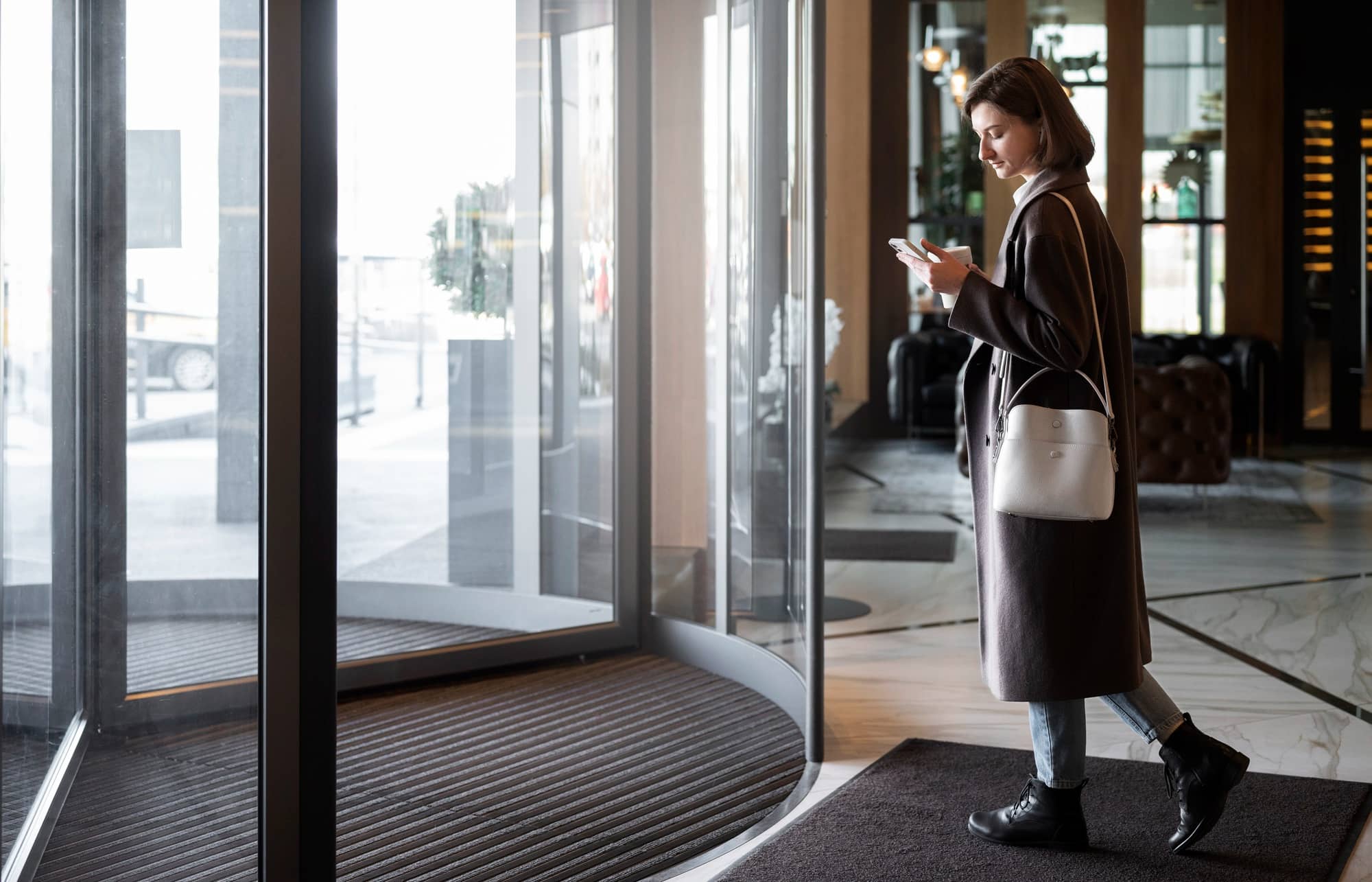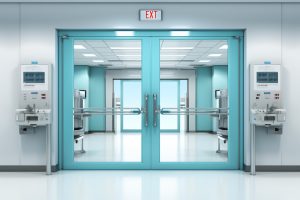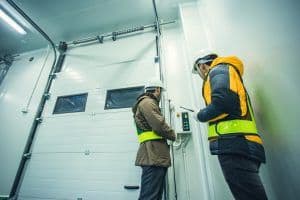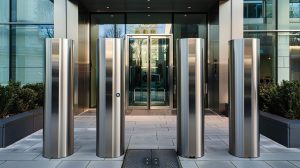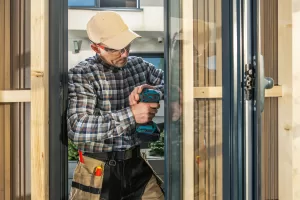Commercial Automatic Doors
05 August, 2024
Commercial automatic doors are a common feature of modern life. They enhance accessibility, convenience, and energy efficiency in a wide variety of settings, from shopping centres and busy offices to educational institutions and hospitals. They make it possible for large numbers of people to enter and exit a building efficiently and smoothly.
Over the decades, the technology behind commercial automatic doors has evolved considerably, making them safer and more reliable while also reducing their relative cost, allowing a greater range of locations to benefit from having them installed.
Where can you have automatic doors?
Commercial automatic doors can be installed in a range of different buildings, each of which may have very specific requirements. Different types and configurations of commercial automatic doors have been developed to address these different needs.
Here are some of the most common applications of commercial automatic doors:
- Hospitals & Healthcare Settings
Across healthcare settings, from GP surgeries, and minor injury clinics, to busy general hospitals, you’ll find commercial automatic doors. Facilitating the free flow of patients, staff, and equipment, they reduce the spread of infections by minimising contact with door handles and surfaces.
To support this further, they will usually be equipped with sensors that detect motion or touchless activations systems. They will typically be installed in entrance areas, operating rooms, patient rooms, and emergency exits.
- Shopping Centres & Retail Settings
Shopping centres and other retail settings will generally have commercial automatic doors installed. Automatic sliding or revolving doors are common at main entrances to facilitate the smooth flow of people in and out of the shopping centre. Smaller stores may use sliding or swing doors to enhance accessibility and security. Automatic doors can also support indoor climate control, a crucial consideration when it comes to customer comfort and energy efficiency.
- Office Buildings
In office buildings, commercial automatic doors are key to supporting accessibility and security. As well as being installed at entrances and exits, they are often used internally, creating better access for meeting rooms and individual office spaces. They are particularly helpful at supporting accessibility for people with disabilities. They can also be integrated with existing security systems, ensuring that access is restricted to authorised personnel. Increasingly, commercial automatic doors play a key role in the overall security infrastructure of office buildings.
- Hotels & Hospitality
In the hotel and hospitality sector, the comfort and security of guests is paramount. It’s not surprising therefore that commercial automatic doors have long been a feature of hotels, conference centres, and other hospitality settings. Automatic revolving or sliding doors are common at the main entrance to hotels, providing easy access for a range of visitors, and making it easier to manage indoor climate. Within hotels, automatic doors are often installed at the entrance to gyms, restaurants, or pool areas, to support seamless, convenient access for all guests.
- Airports & Transportation Hubs
Airports, trains, bus stations, motorway service stations, and other transportation hubs all rely heavily on commercial automatic doors to manage large volumes of passengers efficiently. They will typically be used at entrances, security checkpoints, boarding gates, and exits. Increasingly they are used on station platforms to separate waiting passengers from the train or tram line. Rapid, reliable operation is crucial and automatic doors installed in transport settings ensure security and passenger flow is maintained.
- Public Buildings
Libraries, museums, record offices, and other public institutions frequently feature automatic doors to improve accessibility, while ensuring visitors’ safety and convenience. In such settings, commercial automatic doors help institutions comply with the legal requirements for accessibility, set out in legislation such as the Equality Act 2010. Users of public buildings increasingly expect to find automatic doors to make it easier for people to enter and exit, particularly those with disabilities.
- Industrial & Manufacturing Facilities
Automatic doors are a key component of industrial and manufacturing facilities where they streamline operations and enhance safety. In warehouses and manufacturing plants, high-speed automatic doors are often used to facilitate smooth movement throughout the premises. They also assist with environmental control and improve workflow efficiency. Doors in these kinds of settings are designed to withstand a range of conditions as well as heavier usage patterns.
How do automatic doors work?
Commercial automatic doors use a combination of technologies to facilitate smooth, safe, and efficient entrance and exit into a building. Combining mechanical, electronic, and sensory technologies, a person or object is detected near the door that triggers the opening and closing mechanism.
Typically an automatic door will consist of:
- Sensors & Activation Mechanism
Automatic door operations begin with sensors that detect the presence of an individual or other movements. There are several types of sensors that are used in automatic doors.
Motion sensors use infrared or microwave technology to detect movement near the door. When someone approaches, a signal is transmitted from the sensor to the door control system to open the door.
Pressure sensors are installed in mats or pads on the floor near the door. These work by detecting weight or pressure changes that then trigger the door to open.
Optical sensors use lasers or light beams that detect interruptions caused by a person or object approaching the door.
Touchless sensors use proximity or gesture recognition technology that allows users to wave or perform specific gestures which then activate the door. This kind of technology is widely used in healthcare settings where hygiene is a priority.
- Door Control System
The sensors on commercial automatic doors send signals to the door control mechanism. These then process the information and activate the door’s opening mechanism. The system will typically incorporate a microcontroller or programmable logic controller (PLC) that interprets sensor data to manage the door’s operation.
- Door Opening Mechanisms
Mechanical components facilitate the physical opening and closing of commercial automatic doors.
Sliding doors slide horizontally along a track. This will usually be powered by a belt drive or a gear system that’s connected to an electric motor. This system regulates the motor to ensure that movement is smooth and efficient.
Swinging doors pivot on hinges that are operated by an electric motor that drives a linkage system to open and close the door. They are often a good choice in smaller spaces where a sliding mechanism may be impractical.
Revolving doors are made up of multiple panels that rotate around a central axis. This rotation is powered by an electric motor with the speed carefully controlled to ensure the safety of users.
Finally, folding doors are made up of several panels on hinges that withdraw back on themselves. They are driven by a motor and track system that guides the panels.
- Safety Features
Commercial automatic doors have to meet a range of safety criteria. Several safety features will be incorporated to prevent accidents and injuries from occurring.
Additional safety sensors detect obstructions in the path of the door. These will prevent the door from closing if a person or an object is detected. Manual override buttons or switches allow users to quickly stop the door in case of an emergency. Force limitation systems limit the force that can be exerted by the door to prevent injury if someone is caught.
In some cases, battery backup may be installed to ensure that the doors can continue operating in the event of a power failure.
Commercial Automatic Doors from Safetell
At Safetell, we’ve established ourselves as one of the UK’s leading providers of professional door automation solutions for businesses and other organisations. Our focus is on delivering high-quality products that meet your unique requirements from trusted manufacturers. Our selection process means that we only recommend the best-suited solutions, without being tied to a specific brand or manufacturer.
Our team will assess your needs, the kind of door installation and automation you require, and then propose the most appropriate products for your business. Our emphasis throughout is on quality, reliability, and performance.
Contact us to find out more about commercial automatic doors and how we can help find the right solution for your needs.
